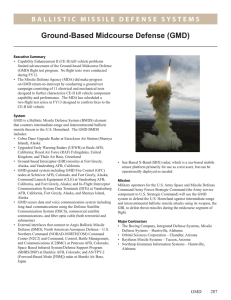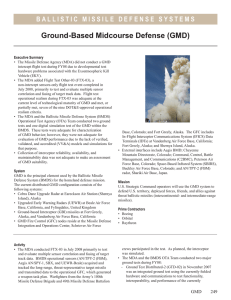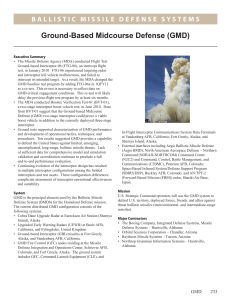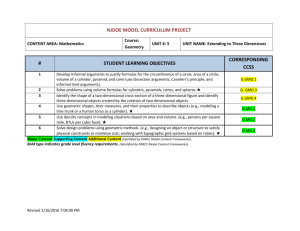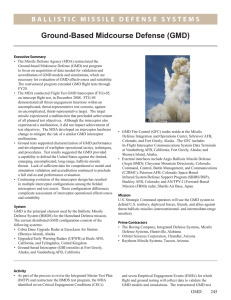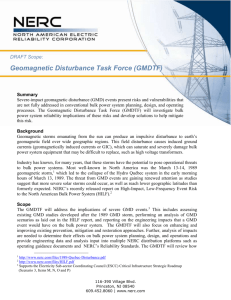Ground-Based Midcourse Defense (GMD)
advertisement
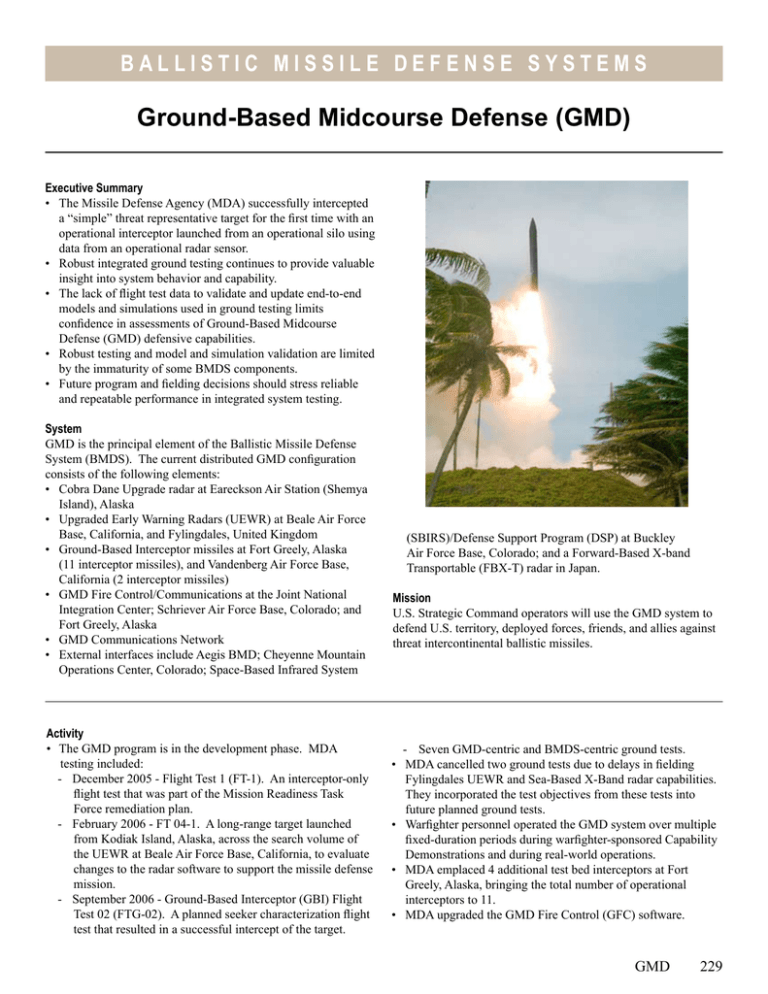
BALLISTIC MISSILE DEFENSE SYSTEMs Ground-Based Midcourse Defense (GMD) Executive Summary • The Missile Defense Agency (MDA) successfully intercepted a “simple” threat representative target for the first time with an operational interceptor launched from an operational silo using data from an operational radar sensor. • Robust integrated ground testing continues to provide valuable insight into system behavior and capability. • The lack of flight test data to validate and update end-to-end models and simulations used in ground testing limits confidence in assessments of Ground-Based Midcourse Defense (GMD) defensive capabilities. • Robust testing and model and simulation validation are limited by the immaturity of some BMDS components. • Future program and fielding decisions should stress reliable and repeatable performance in integrated system testing. System GMD is the principal element of the Ballistic Missile Defense System (BMDS). The current distributed GMD configuration consists of the following elements: • Cobra Dane Upgrade radar at Eareckson Air Station (Shemya Island), Alaska • Upgraded Early Warning Radars (UEWR) at Beale Air Force Base, California, and Fylingdales, United Kingdom • Ground-Based Interceptor missiles at Fort Greely, Alaska (11 interceptor missiles), and Vandenberg Air Force Base, California (2 interceptor missiles) • GMD Fire Control/Communications at the Joint National Integration Center; Schriever Air Force Base, Colorado; and Fort Greely, Alaska • GMD Communications Network • External interfaces include Aegis BMD; Cheyenne Mountain Operations Center, Colorado; Space-Based Infrared System Activity • The GMD program is in the development phase. MDA testing included: - December 2005 - Flight Test 1 (FT-1). An interceptor-only flight test that was part of the Mission Readiness Task Force remediation plan. - February 2006 - FT 04-1. A long-range target launched from Kodiak Island, Alaska, across the search volume of the UEWR at Beale Air Force Base, California, to evaluate changes to the radar software to support the missile defense mission. - September 2006 - Ground-Based Interceptor (GBI) Flight Test 02 (FTG-02). A planned seeker characterization flight test that resulted in a successful intercept of the target. (SBIRS)/Defense Support Program (DSP) at Buckley Air Force Base, Colorado; and a Forward-Based X-band Transportable (FBX-T) radar in Japan. Mission U.S. Strategic Command operators will use the GMD system to defend U.S. territory, deployed forces, friends, and allies against threat intercontinental ballistic missiles. - Seven GMD-centric and BMDS-centric ground tests. • MDA cancelled two ground tests due to delays in fielding Fylingdales UEWR and Sea-Based X-Band radar capabilities. They incorporated the test objectives from these tests into future planned ground tests. • Warfighter personnel operated the GMD system over multiple fixed-duration periods during warfighter-sponsored Capability Demonstrations and during real-world operations. • MDA emplaced 4 additional test bed interceptors at Fort Greely, Alaska, bringing the total number of operational interceptors to 11. • MDA upgraded the GMD Fire Control (GFC) software. GMD 229 BALLISTIC MISSILE DEFENSE SYSTEMs Assessment • More robust GMD ground and flight testing increased confidence in its ability to perform the BMDS mission. - FT-1 demonstrated silo launch and fly out of an operationally-configured interceptor and kill vehicle. - FT 04-1 demonstrated performance of an operational radar, radar interoperability with GMD, and GMD simulated engagement of a long-range ballistic threat target. The radar tracked the target and transmitted target data via the Ground-based Communications Network to the Joint National Integration Center in Colorado Springs, Colorado, and to the C2BMC. GMD simulated system response up to, and including, development of an intercept solution. GMD simulated the interceptor for this test. - FTG-02 demonstrated end-to-end performance in a flight test using warfighter operators, an operational midcourse sensor, and an operationally-configured GMD system. Although not a primary or secondary objective of the flight test, GMD intercepted the target. • During Capability Demonstrations and real-world operations, GMD demonstrated day-to-day system operations over multiple extended periods. • MDA’s more robust pre-flight ground testing, initiated in response to Mission Readiness Task Force recommendations, identified and mitigated serious challenges to flight test success. • FTG-02 incorporated operational realism consistent with the maturity of the GMD system in this developmental flight test: - First use of a production GBI and production kill vehicle against a “simple” threat representative target. - First use of an operational sensor to support a GBI weapon task plan. - A successful “single-thread” (one engagement sequence group) end-to-end system test of the BMDS - one sensor providing the GMD Fire Control with tracks of the threat. 230 GMD Achieving an intercept was not a primary or secondary test objective. It was not an operationally realistic end-to-end test of the total integrated BMDS, which includes many of the other elements (e.g., multiple sensors (radars) requiring accurate sensor fusion and track correlation by the operationally-relevant GMD Fire Control). As the system matures, these artificialities should disappear allowing for more realistic, operational end-to-end tests. - Warfighters operated the GFC and all command and control nodes except the Beale UEWR, the primary intercept sensor. Two contractors and a warfighter subject matter expert setup and monitored the radar which operated in its automatic mode. • Testing is limited by the lack of maturity of some components that are still in early development. • Challenging, integrated BMDS demonstrations remain an important objective for future testing. Recommendations • Status of Previous Recommendations. MDA has taken actions on five of the seven FY05 DOT&E recommendations. The following recommendations remain valid: FY05 #2: MDA has put processes into place and is developing an evaluation-based test strategy. MDA has made contractual and test program changes, and continues to do so to reach full implementation. FY05 #3: Through contract modifications and user forums, MDA continues to work to maximize data collection to determine the GMD systems operational reliability, availability, and maintainability. MDA needs to develop and implement systematic data collection, analysis, and reporting procedures for all BMDS elements. • FY06 Recommendations. None.
